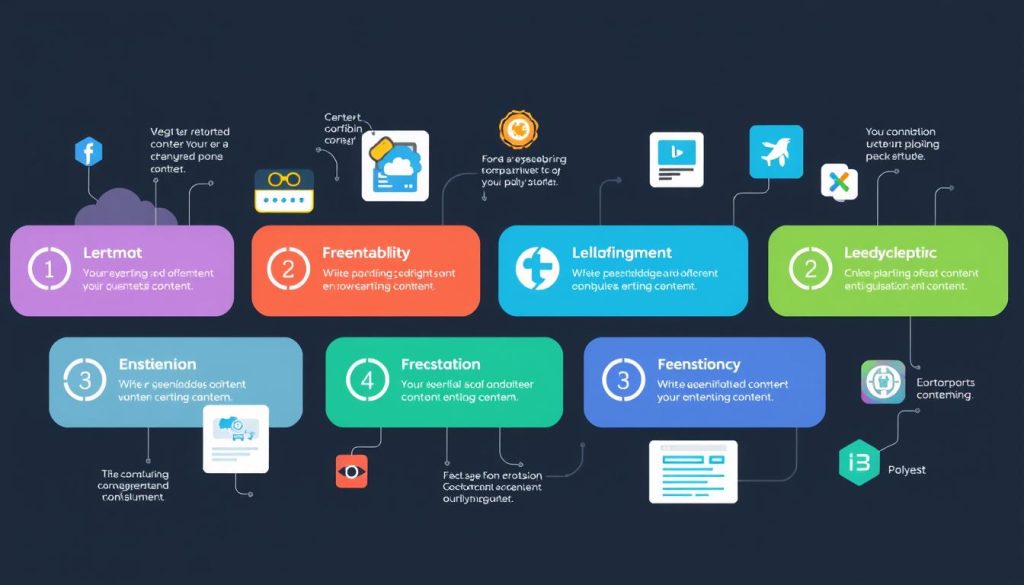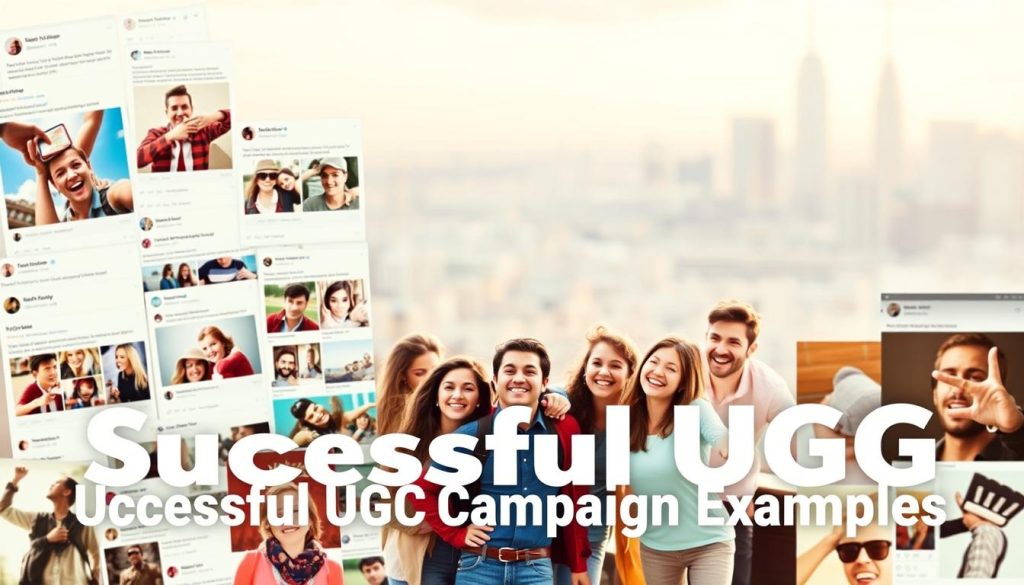In today’s digital landscape, authenticity is key to capturing the attention of your target audience. We’re witnessing a significant shift in consumer behavior, with 92% of consumers trusting user-generated moments over polished ads. This trend is more than just a fad; it’s a clear signal that genuine customer experiences are driving brand success.
As a result, businesses are seeing a 29% boost in web conversions when implementing effective user-generated content marketing strategies. By leveraging the power of real stories from real people, brands can create a more relatable and engaging marketing approach. We will explore how this shift can help you maximize your ROI and drive business growth.
Key Takeaways
- Discover how user-generated content is revolutionizing modern marketing strategies
- Learn why consumers trust UGC over traditional advertising
- Understand the impact of UGC on web conversions and brand success
- Explore the benefits of incorporating UGC into your marketing approach
- Gain insights into creating effective UGC campaigns that drive results
Understanding User-Generated Content (UGC)
In today’s digital landscape, user-generated content is revolutionizing the way brands interact with their audiences. User-generated content (UGC) refers to any content created by individuals rather than the brand itself. This can include a wide range of formats such as social media posts, reviews, photos, videos, and blog posts.
Defining User-Generated Content
User-generated content is any form of content created by people who are not necessarily affiliated with a brand but have an experience or opinion worth sharing. It encompasses everything from a customer’s Instagram story about a new purchase to a tweet praising a brand’s customer service. UGC is genuine, authentic, and offers a real perspective amidst traditional corporate advertising. The authenticity of UGC is what makes it so valuable to brands and consumers alike.
| Types of UGC | Examples | Platforms |
|---|---|---|
| Reviews and Testimonials | Product reviews, service testimonials | Company website, social media |
| Photos and Images | Product showcases, brand experiences | Instagram, Facebook |
| Videos and Reels | Product demos, brand stories | YouTube, TikTok, Instagram |
Who Creates User-Generated Content?
User-generated content is created by different groups of individuals who engage with and support a brand in various ways. These include: customers who use products and share their experiences, brand loyalists who showcase a deep affinity for products, social media followers who interact with brands online, and UGC creators who specialize in making sponsored content that looks and feels like genuine customer posts. Understanding who creates UGC is crucial for brands looking to harness its power effectively.
By recognizing the diverse groups that contribute to UGC, brands can develop targeted strategies to encourage and leverage this valuable content. As we continue to explore the world of user-generated content, it’s essential to understand its various forms and creators to maximize its potential in marketing strategies.

Types of User Generated Content Marketing
User-generated content (UGC) is a multifaceted marketing strategy that encompasses various content types, each offering unique engagement opportunities. To effectively leverage UGC, businesses must understand its different forms and how they can be utilized to achieve marketing objectives.
Reviews and Testimonials
Reviews and testimonials serve as powerful social proof, influencing potential customers’ purchasing decisions. They provide firsthand experiences from existing customers, building trust and credibility for the brand.
For instance, a study found that 85% of consumers trust online reviews as much as personal recommendations. Brands can encourage customers to leave reviews on their websites or social media platforms.
Photos and Images
Photos and images showcasing products or services in real-world contexts help prospects visualize themselves using the offerings. User-submitted images add authenticity to marketing campaigns, making them more relatable.
A notable example is GoPro’s user-generated content campaign, where they feature customer-submitted photos and videos on their social media channels.
Videos and Reels
Videos and reels have become increasingly popular, demonstrating product features and benefits in engaging formats. User-created videos often outperform brand-created content due to their authenticity and relatability.
For example, Apple’s #ShotOniPhone campaign encouraged users to share their best iPhone photos, resulting in a vast library of user-generated content.
Social Media Posts
Social media posts from users can spread brand awareness organically, creating ripple effects that extend a brand’s reach beyond paid advertising. By leveraging user-generated social media content, brands can tap into the networks of their customers.
Blog Posts and Articles
Blog posts and articles written by users provide in-depth experiences and perspectives, offering detailed insights that brands can repurpose across multiple marketing channels. These long-form content pieces can be particularly valuable for SEO purposes.
| Type of UGC | Benefits | Examples |
|---|---|---|
| Reviews and Testimonials | Builds trust, provides social proof | Product reviews on websites |
| Photos and Images | Authenticity, visual engagement | GoPro’s user-generated images |
| Videos and Reels | Engaging, demonstrates product features | Apple’s #ShotOniPhone campaign |
| Social Media Posts | Organic reach, brand awareness | User-generated posts on Twitter, Instagram |
| Blog Posts and Articles | In-depth insights, SEO benefits | User-written blog posts about products |

The Business Value of User-Generated Content
The power of user-generated content lies in its ability to build brand trust and authenticity, driving business growth through genuine customer connections. As consumers increasingly seek authenticity in their interactions with brands, UGC has emerged as a vital component of modern marketing strategies.
Building Authenticity and Trust
UGC carries a hallmark of authenticity that traditional sales and marketing materials struggle to match. Research indicates that individuals are three times more likely to perceive UGC as authentic compared to brand-created content. This sentiment is echoed by 88% of consumers who prioritize authenticity when choosing brands to support.
Providing Social Proof
UGC serves as powerful social proof, influencing purchasing decisions. More than 50% of millennials report that recommendations from friends and family heavily influence their buying choices. By showcasing real customers’ experiences, businesses can build credibility and trust with potential customers.

Cost-Effectiveness of UGC
One of the significant advantages of UGC is its cost-effectiveness. By leveraging content created by customers, businesses can reduce the costs associated with professional content creation and high-profile influencer partnerships. This approach not only delivers superior ROI but also fosters a more engaging and personalized marketing strategy.
Enhancing Brand Loyalty
Inviting customers to create content for a brand transforms them from mere buyers into active members of the brand story, fostering a deep sense of community and brand loyalty. According to PwC’s Customer Loyalty Survey, 52% of people demonstrate their loyalty by recommending brands to others. This highlights the potential of UGC to drive long-term customer engagement and retention.
How UGC Drives ROI
The power of user-generated content lies in its ability to boost ROI through increased conversion rates, enhanced engagement, and reduced marketing costs. By leveraging authentic customer content, businesses can experience a significant improvement in their bottom line.
Increasing Conversion Rates
Campaigns incorporating user-generated content see an average 29% boost in web conversions compared to traditional marketing approaches. This is because UGC provides social proof, making potential customers more likely to trust and engage with a brand. By showcasing real customer experiences, businesses can increase the likelihood of conversion.

Boosting Engagement Metrics
Authentic user content drives engagement across social platforms, increasing time spent with brand content, sharing behavior, and meaningful interactions. This, in turn, leads to greater organic reach, as algorithms reward engaging content. By incorporating UGC into their marketing strategy, businesses can boost their engagement metrics and expand their online presence.
- UGC campaigns lead to increased customer interaction
- Authentic content resonates with target audiences
- Engagement metrics improve, including time spent with brand content and sharing behavior
Reducing Marketing Costs
The use of UGC also reduces marketing costs, as businesses no longer need to invest heavily in content creation. By leveraging customer-generated content, companies can save on production costs while still maintaining a robust marketing strategy. This cost-effectiveness is a key benefit of UGC, making it an attractive option for businesses of all sizes.
In conclusion, UGC drives ROI by increasing conversion rates, boosting engagement metrics, and reducing marketing costs. By incorporating user-generated content into their marketing strategy, businesses can experience a significant improvement in their bottom line and achieve a higher return on investment.
Creating an Effective UGC Strategy
To harness the full potential of user-generated content, we must develop a strategic plan that integrates with our overall marketing objectives. A well-crafted UGC strategy goes beyond understanding the types of content needed from customers; it also involves aligning the UGC campaign with broader social media goals.

Setting Clear Objectives
Firstly, we need to set clear, measurable objectives for our UGC initiatives. This involves determining whether we aim to increase brand awareness, drive conversions, or achieve both. By being specific about our goals, we can create a focused campaign that resonates with our target audience and encourages them to share content that fits our needs.
Identifying Your Target Audience
Next, we must identify the segments of our audience most likely to create valuable content. Understanding our target audience’s preferences, behaviors, and motivations enables us to tailor our UGC requests effectively, increasing the likelihood of receiving high-quality content that aligns with our brand’s marketing needs.
Choosing the Right Platforms
Selecting the optimal platforms for our UGC strategy is crucial. We need to consider where our target audience is most active, the types of content they prefer to create, and which channels align best with our marketing objectives. By focusing on the most relevant platforms, we can maximize the impact of our UGC campaign.
Developing Campaign Guidelines
To ensure the success of our UGC campaign, we must develop clear campaign guidelines. These guidelines should communicate exactly what kind of content we’re looking for, making it easy for users to create material that serves our marketing needs while expressing their authentic experiences. By providing clear instructions, we can encourage more participation and receive content that is relevant and useful.
By following these steps, we can create a comprehensive UGC strategy that not only aligns with our broader business objectives but also leverages the unique benefits of user-generated content to drive engagement, build brand loyalty, and ultimately maximize ROI.
Best Practices for Encouraging UGC
To maximize the potential of User-Generated Content (UGC), brands must adopt strategies that encourage their audience to create and share content. By doing so, they not only enhance their marketing efforts but also build a more engaged community around their brand.
Creating Branded Hashtags
Creating a branded hashtag is a powerful way to encourage UGC. It serves as a collection mechanism and a rallying point for your community, making it easier to find and share content. Research shows that 50% of consumers are more likely to create content when brands provide clear guidance, such as through hashtag campaigns. A unique hashtag can help track user-generated content and create a sense of belonging among your audience.
Running Contests and Challenges
Running contests and challenges is an effective strategy to motivate users to create and share content related to your brand. By initiating trends or contests, you can energize your audience and generate buzz around your brand. This approach not only increases engagement but also produces authentic brand-related material that can be leveraged in your marketing efforts.
Recognizing and Rewarding Contributors
Recognizing and rewarding contributors is crucial for a successful UGC strategy. By crediting the original creator and rewarding participation, you show respect for their efforts and encourage others to contribute. This can be achieved through featuring content on your channels, offering exclusive access, or providing tangible incentives.
Providing Clear Submission Guidelines
Clear submission guidelines are essential for encouraging UGC. By making it easy for users to understand what kind of content you’re looking for, you can increase participation and ensure that the content aligns with your marketing objectives. This clarity helps in streamlining the process and making it seamless for users to share their content.
Obtaining Proper Permissions
Before using customer-generated content in your marketing, it’s crucial to obtain proper permissions. This not only respects the creator’s rights but also protects your brand from potential legal issues. Always request permission and credit the original creator to foster trust and encourage ongoing participation.
Tools and Platforms for Managing UGC

Effectively leveraging user-generated content (UGC) requires a robust set of tools and platforms. These not only streamline the process of collecting and sharing UGC but also ensure that your efforts align with your brand’s goals.
Social Media Management Tools
Social media management platforms allow you to schedule posts, engage with your audience, and monitor mentions of your brand across multiple social networks. Tools like Hootsuite and Sprout Social can be incredibly helpful in identifying and reposting UGC, facilitating a more dynamic interaction with your audience.
Content Curation Platforms
There are specialized platforms that curate and aggregate content from various sources, including social media, blogs, and websites. They help brands find high-quality UGC relevant to their audience.
Analytics and Tracking Software
Understanding the impact of UGC on your brand is crucial. Analytics platforms provide insights into how users interact with your content, tracking metrics such as engagement rates, reach, and conversions.
Rights Management Solutions
Managing the legal aspects of UGC is vital. Rights management solutions help identify and manage copyright claims, ensuring that your brand respects the rights of content creators.
By leveraging these tools and platforms, brands can efficiently manage UGC, enhance their marketing strategies, and ultimately drive ROI.
Successful UGC Campaign Examples
The effectiveness of User-Generated Content is exemplified through various successful campaigns across different industries. By examining these examples, we can glean valuable insights into how UGC can be leveraged to enhance brand visibility, engagement, and overall marketing strategy.
GoPro’s User Videos Strategy
GoPro’s UGC strategy revolves around encouraging users to share their adventure videos shot with GoPro cameras, using the hashtag #GoPro. This approach has flooded social media with thrilling content, showcasing the camera’s durability and quality. By turning users into brand ambassadors, GoPro significantly boosted its brand visibility and sales, with many videos going viral. The success of this campaign underscores the importance of aligning UGC with brand identity. 
Starbucks’ White Cup Contest
Starbucks invited customers to doodle on their white cups and share their creations on social media, generating widespread participation and buzz. The winning design was turned into a limited-edition Starbucks cup, showcasing the brand’s commitment to customer creativity and engagement. This campaign not only increased foot traffic but also strengthened the emotional connection between Starbucks and its customers, demonstrating the power of UGC in building brand loyalty.
Airbnb’s Community Stories
Airbnb’s UGC strategy involves encouraging guests to share their travel experiences and accommodations through photos and stories using specific hashtags. This approach has filled Airbnb’s social media feeds with authentic, relatable content that resonates with the wanderlust of its audience, driving bookings and building a strong community of travel enthusiasts. Airbnb’s effective use of UGC reinforces the idea that authenticity drives engagement and is a key component of successful marketing campaigns.
Apple’s #ShotOniPhone Campaign
Apple’s #ShotOniPhone campaign showcased the professional-quality photography capabilities of their devices through everyday user photos. By turning customers into product demonstrators, Apple effectively highlighted the features of their iPhones, creating a compelling narrative that resonated with potential customers. This campaign exemplifies how UGC can be used to demonstrate product value and build brand credibility.
These successful UGC campaigns demonstrate the potential of User-Generated Content to transform brand marketing strategies. By leveraging customer creativity and authenticity, brands can create engaging narratives that drive engagement, boost sales, and foster a loyal community.
Measuring the Success of Your UGC Campaigns
Measuring the success of your UGC campaigns is vital to understanding their impact on your marketing strategy. To do this effectively, you need to track the right metrics and use the appropriate tools.
Key Performance Indicators (KPIs)
To measure the success of your UGC campaigns, you need to identify the essential Key Performance Indicators (KPIs). These include engagement metrics, conversion rates, UGC volume, and sentiment analysis. By tracking these KPIs, you can gain a comprehensive view of your campaign’s performance and make data-driven decisions.
Analytics Tools and Techniques
To gather meaningful data about your UGC campaigns, you can use analytics tools and social listening platforms. Tools like Hootsuite Analytics and Sprout Social offer insights into how UGC performs and impacts brand metrics. You can track engagement rates, UGC volume, conversion rates, and changes in brand sentiment. By leveraging these tools, you can refine your UGC strategy and improve its effectiveness.
Calculating ROI from UGC
To calculate the true ROI of your UGC initiatives, you need to account for both direct conversion impacts and the less tangible but valuable brand equity benefits. By using analytics tools to track the performance of your UGC campaigns, you can estimate the revenue generated by these campaigns and compare it to the cost of implementing them. This will give you a clear understanding of your UGC campaign’s ROI and help you make informed decisions about future investments.
Conclusion
As we’ve seen throughout this article, user-generated content is crucial for a successful marketing strategy. By leveraging UGC, businesses can build genuine customer relationships, enhance brand loyalty, and drive results. Auditing current UGC use, developing a strategy, and streamlining the process can deepen customer engagement and strengthen the brand’s digital presence.
